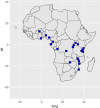Cost of treating severe malaria in children in Africa: a systematic literature review
- PMID: 39522014
- PMCID: PMC11550527
- DOI: 10.1186/s12936-024-05173-w
Cost of treating severe malaria in children in Africa: a systematic literature review
Abstract
Background: Malaria is a major cause of ill health and death in children in Africa. The disease also imposes a severe social and economic burden on households and health systems and is strongly associated with poverty. This study summarizes the most up-to-date cost of treating severe malaria in children in Africa.
Methods: A systematic search was conducted in PubMed, Embase, Cinahl, and Web of Science databases. Google and Google Scholar were searched for grey literature followed by scanning of the reference lists of the previous systematic reviews. The search was limited to children < 12 years, malaria-endemic countries in Africa, and the English language. All costs were adjusted to the year 2023.
Results: 19 studies conducted in 12 countries were identified: 14 reported provider costs, and 11 household costs. Out of the 19 studies found, 11 were published before 2018 while 11 reported data that are currently more than ten years old. Studies varied methodologically and in the scope of resources included to estimate the cost. The provider costs ranged from USD 27 in Uganda to USD 165 per patient in Kenya (median value USD 90), while household costs ranged from USD 13 in Kenya to USD 245 per patient in Gabon (median value USD 50). All identified household malaria treatment costs except one represented catastrophic health expenditure, making out more than 10% of the monthly Gross National Income per capita in the respective countries.
Conclusion: Evidence on the cost of treating severe malaria in children in Africa is scarce. However, the few existing studies show that severe malaria in children imposes a significant economic burden on the providers and households. More studies are needed, particularly in high-burden high-impact countries, to inform resource allocation decisions.
Keywords: Africa; Child; Cost; Cost of illness; Economic burden; Severe malaria; Severe malarial anaemia.
© 2024. The Author(s).
Conflict of interest statement
The authors declare no competing interests.
Figures
Similar articles
-
The economic burden and catastrophic health expenditures among children with sickle cell anaemia on households in malaria-endemic areas: insights from Uganda and Malawi.BMC Public Health. 2025 Jun 4;25(1):2070. doi: 10.1186/s12889-025-23209-x. BMC Public Health. 2025. PMID: 40468209 Free PMC article.
-
Rethinking the economic costs of hospitalization for malaria: accounting for the comorbidities of malaria patients in western Kenya.Malar J. 2021 Oct 30;20(1):429. doi: 10.1186/s12936-021-03958-x. Malar J. 2021. PMID: 34717637 Free PMC article.
-
Who pays to treat malaria and how much? Analysis of the cost of illness, equity and economic burden of malaria in Uganda.Health Policy Plan. 2025 Jan 11;40(1):52-65. doi: 10.1093/heapol/czae093. Health Policy Plan. 2025. PMID: 39405172 Free PMC article.
-
The evidence base on the cost-effectiveness of malaria control measures in Africa.Health Policy Plan. 1999 Dec;14(4):301-12. doi: 10.1093/heapol/14.4.301. Health Policy Plan. 1999. PMID: 10787646 Review.
-
Cost of diabetes mellitus in Africa: a systematic review of existing literature.Global Health. 2018 Jan 16;14(1):3. doi: 10.1186/s12992-017-0318-5. Global Health. 2018. PMID: 29338746 Free PMC article.
Cited by
-
Current Developments in Malaria Vaccination: A Concise Review on Implementation, Challenges, and Future Directions.Clin Pharmacol. 2025 Apr 1;17:29-47. doi: 10.2147/CPAA.S513282. eCollection 2025. Clin Pharmacol. 2025. PMID: 40191019 Free PMC article. Review.
References
-
- WHO. World malaria report 2023. Geneva: World Health Organization; 2023.
-
- WHO: High burden to high impact: a targeted malaria response. https://www.who.int/publications/i/item/WHO-CDS-GMP-2018.25. Geneva: World Health Organization; 2018.
-
- Sachs J, Malaney P. The economic and social burden of malaria. Nature. 2002;415:680–5. - PubMed
Publication types
MeSH terms
Substances
LinkOut - more resources
Full Text Sources
Medical




